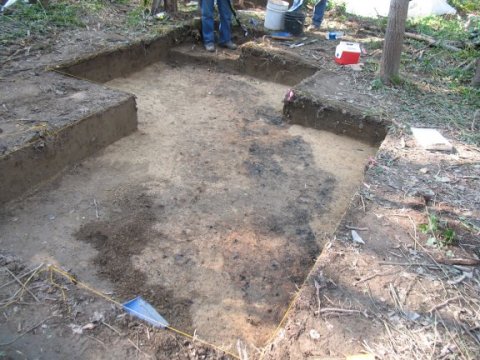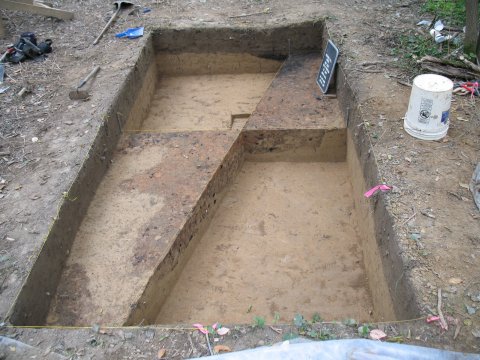Since its discovery, this feature has been difficult to classify and interpret. At this time, the ring-shaped ditch feature at the Stratton Mill Creek site cannot be dated. AMS and dendro chronometric dates post-dated A.D. 1600 and extend into the mid-twentieth century. Modern rye seeds were found within the ring/ditch further complicating matters. A single nut shell was AMS dated to around 6,000 B.C. The first question is whether the feature is precontact. Despite the more modern dates and rye seeds, there were numerous pieces of precontact material culture in the ditch and the interior portions of the feature to conclude that the feature dates to the precontact period. Could it be associated with the one precontact date of pre-6000 B.C.? It is doubtful that this is an accurate association. There is no material culture dating to this period anywhere on the site. There are also no recorded discoveries that we could find of similar features dating to the early Middle Archaic period. No late precontact or Protohistoric material culture that might support the more recent dates was recovered either.
Material culture representative of everyday activities (stone tools, waste material from making stone tool [some used as tools themselves], and pitted stones) was associated with the feature. However, material culture associated with rituals, such as hematite/red ochre pieces, and material culture possibly used in the manufacture of ritual objects, such as the slate ulu (rare for this area) and slate fragments, argue against the structure having been used only for domestic, or everyday purposes.


The ring-shaped ditch at Stratton Mill Creek is similar to Adena ceremonial circles of the Ohio Valley which date roughly to the Early Woodland of the Upper Susquehanna Valley (ca. 400 B.C.-A.D. 250). These ceremonial circles are surrounded by a ditch, but the excavated soil was placed outside the ditch (Clay 1998:9). In time, some of the circles had a mound constructed inside. One or more entrances were present. For some of the circles, an inner circle of posts was present adjacent to the ditch. Similar to Adena ritual structures, the ring-shaped ditch feature at Stratton Mill Creek is circular with post molds along the ditch interior and exterior. Those in the interior of the ring may have been supports for a superstructure, such as a roof, or could represent platforms. A mound may have been present at one time but plowing activities may have eliminated any traces.


In the Midwest and to a lesser extent New York state, the Adena and Hopewell ceremonial structures (mounds, earthen enclosures) are mostly mounds that cover burials and contain a diverse assemblage of ceremonial objects (Clay 1998; Hays 1995). PAF archaeologists excavated the entire interior of the Stratton Mill ring feature in consultation with the Onondaga and Oneida Nations, and no evidence of pit features was found. It is possible that this was a mound at one time since it appears that the ditch was infilled during the seventeenth through mid-twentieth centuries. The ditch was subjected to intense fire evidenced by fire-reddened soil and burned logs. It is possible that an older mound structure (represented by the daub and post molds), with more recent trees growing in its interior, burned and was pushed (through natural or human means) into the ditch. The area may have been leveled in historic times to permit farming. The Middle Archaic date obtained may represent a feature that was subsumed into the trench during the trench excavations and the Middle Archaic feature is now not visible to us.
There is little evidence that the feature dates to the Late Prehistoric/Protohistoric period. However, its Adena/Hopewell affiliation deserves another look. There is an Early Woodland dated feature and cluster of material culture on the floodplain of the Stratton Mill Creek site, but the major time period present on the site is the Transitional period. There is datable material culture supporting a Transitional period of site use. The same is not true of the Early Woodland. A roasting platform on the floodplain dates to the Early Woodland, but this type of feature is common during the Transitional period on sites just over the border into Pennsylvania. It is possible that this Early Woodland feature, dated to 174-19 B.C. and 13-0 B.C. (calibrated at 2 sigma), documents a persistence of the Transitional period past its accepted end date (c. 500 B.C.) in this region. Versaggi and Knapp 2000 have demonstrated this persistence elsewhere in the area and obtained similar dates to those at Stratton Mill Creek. The ring/ditch feature did contain the only two fragments of steatite found on the site, and these were within the feature enclosure. This material is associated with the Transitional period. If the ring/ditch feature is a late manifestation of the Transitional period, then it would represent an unusual occurrence in this part of the Susquehanna Valley, just as it would if it was an Early Woodland associated feature. Domestic structure or ceremonial structure, Transitional or Early Woodland, the enigma still exists. Either way, it is a unique discovery in this region and we continue to search for similar examples.